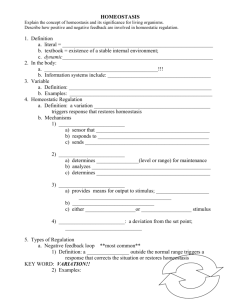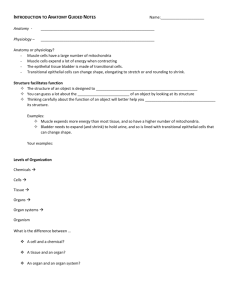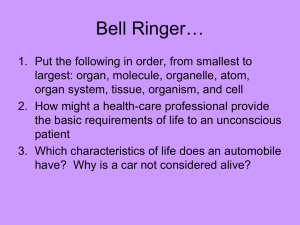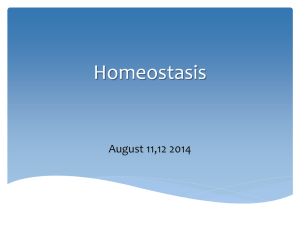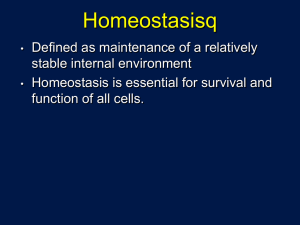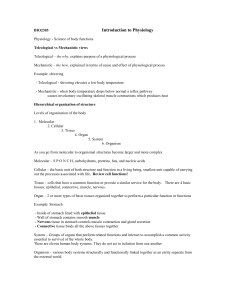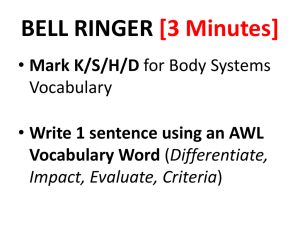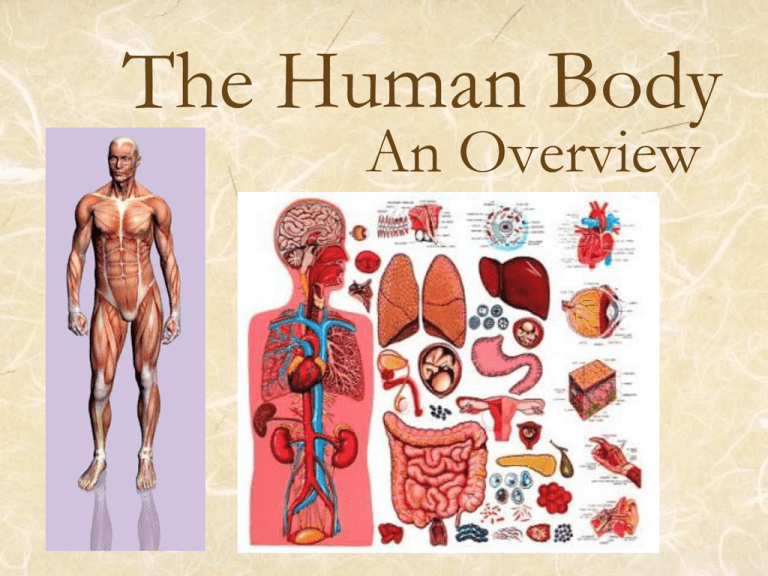
The Human Body
An Overview
A. ANATOMY
• From Latin tomy (to cut) and ana (apart)
• It’s the study of structure and shape of the body
and its parts
• Two types:
– Gross anatomy: large structures, easily observable
– Microscopic anatomy: small structures only visible
with microscope
Gross Anatomy
Microscopic anatomy
B. LEVELS OF STRUCTURAL ORGANIZATION
• Structural complexity
Six levels of complexity
o Chemical level
Atoms: smallest building blocks of matter
Molecules: combinations of atoms to make
water, sugars, and proteins
- Atoms combine to form molecules
Nitrogen
o Cellular level
Molecules combine to form cells, which
vary in size and shape, reflecting different
functions of body
o Tissue level
Similar types of cells group to form tissues
- Four basic tissue types:
> Epithelial tissue (skin, membranes)
> Connective tissue (tendons, cartilage, ligaments and
bone)
> Muscular tissue (muscles)
> Neural tissue (spinal cord, brain matter)
o Organ level
Tissue or multiple tissues that form a structure
that performs a specific function
- Ex: small intestine is made out of all four tissue
types
o Organ system level
Group of organs that cooperate to accomplish a
common purpose
- Ex: digestive system includes esophagus, stomach, small
and large intestines, and more
Total of 11 organ systems
- How they work = physiology!
o Organismal level
Highest level of organization
- Human organisms have similar organ systems as
chimpanzees, but very different organ systems
than mosquitoes
C. PHYSIOLOGY
• Studies functions (how it works) of human
body and its parts
– Anatomists observe structures while
physiologists employ experimentation
• Organ systems
Integumentary system
o External covering of the body (skin)
Protects deeper tissue from injury
or infection
Synthesizes vitamin D
excretes salts and urea in
perspiration
helps regulate body temperature
contains pain, temperature, and
pressure receptors for
environmental cues
Muscular system
o Muscles of body
Contract or shorten to move
skeleton
Maintains posture
Produces heat
Skeletal system
o All bones, cartilages, ligaments and
joints make up skeletal system
Protects and supports body
organs
Provides muscle attachment for
movement
Forms blood cells (hematopoiesis)
in bone marrow
Provides and stores minerals
Nervous system
o Brain, spinal cord, nerves, and sensory
receptors
Speedy control system that responds
to external stimuli
– Light
– Sound
– Temperature changes
– Pain
– Pressure
Central nervous system (brain and
spinal cord) assesses information and
responds by activating appropriate
effector (muscles or glands)
Endocrine system
o A series of glands that slowly
control body by producing and
releasing hormones for growth,
metabolism, and reproduction
Pituitary gland
Thyroid gland
Parathyroid glands
Adrenal glands
Thymus
Pancreas
Pineal gland
Ovaries (females)
Testes (males)
Cardiovascular system
o Heart and blood vessels
Work together to transport
materials in blood
– Nutrients
– Hormones
– Oxygen
– Carbon dioxide
– Waste
Lymphatic system
o Lymphatic vessels, lymph nodes,
spleen, and tonsils
Returns fluid leaked from blood
back to blood vessels
Lymph nodes (and others) help
cleanse blood and store cells
involved in immunity
Respiratory system
o Lungs, nasal passages, pharynx,
larynx, trachea, and bronchi
Supplies oxygen
Removes carbon dioxide
Digestive system
o Mouth, esophagus, stomach, small
and large intestines, liver, pancreas,
and rectum
Breaks down food
Deliver products to blood for
dispersal to body
– Undigested food leaves body
through anus as feces
Reclaim water for bodily use
Urinary(excretory) system
o Kidneys, ureters, bladder, urethra
Rids body of waste products
– Nitrogen-containing urea and
uric acid from breakdown of
proteins and nucleic acids
Maintains body’s water and
salt/electrolyte balance
Regulates acid-base balance of
blood
Reproductive system
o Males: testes, penis, accessory glands, and ducts
o Females: ovaries, uterine tubes, uterus, and vagina
Sole purpose is to produce offspring
Major Organs
D.LIFE FUNCTIONS
• Organ systems work together to promote health
and well-being of entire body. Must be able to
provide eight functions necessary for living. A
healthy body must …
HINT: these are all VERBS!
• Maintain boundaries
The “inside” remains distinct from the
“outside.”
o Examples include
a cell’s environment maintained by the cell
membrane
the integumentary system protecting organs from
desiccating (drying out), from bacteria and
viruses, from heat and sunlight, and from
chemicals
• Move
Muscle movement is necessary for
o Locomotion: getting us from one place to another, or
for moving muscle for safety (hot stove)
o Movement of substances: getting blood, food, and urine
through their proper organs
•Respond or be irritated
Ability to sense changes (from stimuli) and
react to them
oEx: is automatically removing hand from broken
glass (painful stimulus) that cuts – involuntary
response
oEx: when decrease in oxygen levels detected
(mountains), response is to increase breathing rate to
obtain more oxygen
• Digest
Breakdown of nutrients and absorption into
blood for delivery to all body cells
• Metabolize
Chemical reactions within body cells to
oProduce energy in form of ATP (adenosine
triphosphate)
oMake body structures like bones and muscles
Regulated mainly by hormones secreted by
glands of endocrine system
• Excrete
Eliminate excreta (waste) from digestions and
metabolic reactions
Urine
Feces
• Reproduce
Produce future generations…
o of
identical cells in cell division (repair or
growth)
o of entire organism
• Grow
Increasing cell size and number
o
Must make more cells faster than cells die
HINT: these are all NOUNS!
E. SURVIVAL NEEDS
• In order to maintain the eight functions for living,
the human body must have the following items:
Nutrients
oChemicals for energy and cell building
Carbohydrates
Proteins
Lipids
Vitamins
Minerals
Oxygen
oRequired for chemical reactions
Cellular respiration
Water
60-80% of body
weight
o Necessary for
metabolic reactions
o
Basal body temperature
o 98.6°F or 37°C
Atmospheric pressure
o Standard atmospheric pressure (on earth at
sea level is 760 mmHg or 29.92 inHg)
F. HOMEOSTASIS
• Maintenance of a stable internal environment = a
dynamic state of equilibrium
• Homeostasis must be maintained for normal body
functioning and to sustain life
When needs are being adequately met, body is
functioning smoothly, body demonstrates homeostasis
All organ systems partake in maintaining homeostasis
• Homeostatic imbalance – a disturbance in
homeostasis sets off chain reaction of events
Stimulus
o Produces change in variable
Detection
o Change is detected by receptor
Input
o Information is sent from receptor to control center
Output
o Control center decides what action or response should
be taken
Response
o Action or response feeds back to influence magnitude
of stimulus and returns variable to homeostasis
Overview of Homeostasis
• The body communicates chiefly through
nervous and endocrine systems
Nervous uses electrical signals delivered by
nerves
Endocrine system uses blood borne hormones
• Factor being regulated is called the variable
• All homeostatic control mechanisms have at least
three components
Receptor
o Responds to changes in the environment (stimuli)
o Sends information to control center via afferent pathway
Afferent approaches control center
Control center
o Determines set point at which variable should be maintained
o Analyzes information
o Determines appropriate response
Effector
o Provides a means for response to the stimulus
o Desired response flows along efferent pathway
Efferent exits control center
• Most homeostatic control mechanisms are negative
feedback mechanisms
Negative feedback
oIncludes most homeostatic control mechanisms
oShuts off the original stimulus, or reduces its intensity
oWorks like a household heating system with set point
of 72°F
If it’s too cold, will heat it up by turning on heater
If it’s too warm, will shut off heater until it levels
off
o Hypothalamus, located in brain, regulates
body temperature
• If stimulus produces desired effect, and body needs it to
increase in action, a positive feedback results
Positive feedback
oIncreases the original stimulus to push the variable
even farther away from set point
oIn the body this only occurs in blood clotting, birth of
a baby, breastfeeding, and protein digestion
Cut on hand = stimulus (wasn’t there prior and is not part
of body set-point)
Factor in blood starts to form blood clots
Body wants MORE blood clots so positive feedback
mechanism takes over
- MORE blood clotting factors are in play until wound
heals
Protein in small intestine encourages more enzymes
• Homeostasis is SO important that most disease is a
result of homeostatic imbalance
As we age, body organs become less efficient, and
internal conditions less stable
oEvents put us at increased risk for illness and
produce changes associated with aging
Ex: elastin in connective tissue of skin makes it
able to resume shape after stretching, like a
rubber band
- As we age, elastin production decreases
and/or breaks down, so skin loses ability to
resume shape
G. ANATOMICAL LANGUAGE
• Can’t always describe body as left and right or top
and bottom because so many protrusions and
bends. Have specific terminology to describe
locations of the body.
• Exact terms are used for
Positions
Directions
Regions
Structures
Positions
o Initial point of reference is always the
standard position called anatomical
position regardless of position body
happens to be in (like sitting)
Body standing erect
Feet parallel
Arms hanging at sides, palms facing
forward
o Two major positions:
Anterior – front of body in anatomical
position
Posterior – back of body in
anatomical position
Regions
o Anterior body
landmarks
See page 13 of book
(don’t need to know
for test)
o Posterior body
landmarks
See page 13 of book
(don’t need to know for
test)
Directions
opposites
opposites
opposites
o Used to describe body structure is in relation to
another.
Superior – toward head
Inferior – away from head; below
Anterior – toward or at front; in front of
Posterior – toward or at back; behind
Medial – toward or at midline
Lateral – away from midline
Intermediate – between a more medial and more
lateral structure
opposites
opposites opposites
Proximal – close to origin of body part or point
of attachment of a limb to the body trunk
Distal – farther from origin of a body part or
point of attachment of a limb to the body trunk
Superficial – toward or at body surface
Deep – away from body surface; more internal
Supine – lying face upwards
Prone – lying face down
Structures
o Planes and sections
Midsagittal – left &
right
Frontal – anterior
& posterior
Transverse – top &
bottom
Oblique - diagonal
o Body cavities
Dorsal side (posterior)
Ventral side(anterior)

